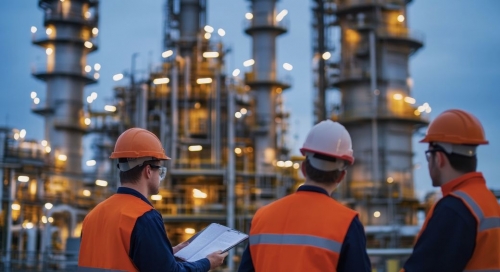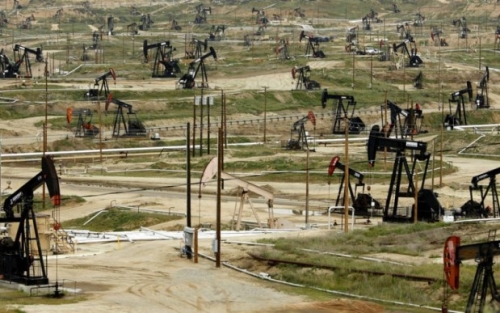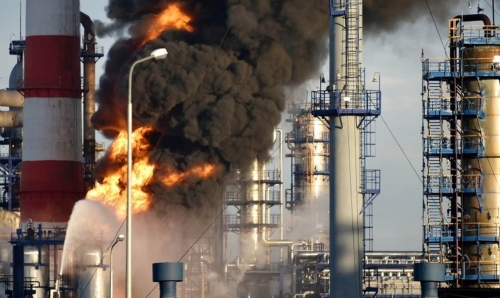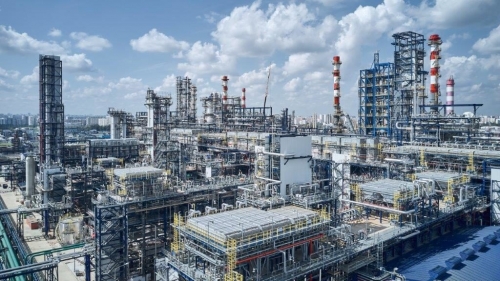Oil prices fell for the week on the back of OPEC+ members’ discussion about an additional supply increase in June. Uncertainty around tariff talks between the U.S. and China contributed the decline later in the week.
BKR Rig Count | The total active drilling rigs in the United States increased by 2 last week, to 587. Oil rigs increased by 2 to 483, and gas rigs increased by 1 to 99. Rig count in the Permian Basin remained flat at 289 | Apr 25 | BKR NAM Rig Count
US Crude Inventories, excluding those in the Strategic Petroleum Reserve (SPR), increased by 0.2 MMbbl to 443.1 MMbbl (about 5% below the 5y average for this time of year). On the products side, gasoline decreased by 4.5 MMbbl (3% below the 5y average). Distillate fuels decreased by 2.4 MMbbl (13% below the 5y average). Total commercial petroleum inventories decreased by 0.7 MMbbl | Apr 18 | EIA Weekly Report
OPEC+ group was reportedly considering further increasing its oil output for a second consecutive month in June. This comes on the back of tensions amongst its members over production compliance, and was further compounded by Kazakh Energy Minister stating that they would prioritize "national interests" over those of OPEC+. The minister would later state that Kazakhstan is committed to fulfilling its OPEC+ obligations. CEO of Energy Aspects said "Kazakhstan’s statement confirms our belief that OPEC+ will implement another accelerated unwind for three months again at the May meeting. It may also continue in July or through the summer" | Apr 25 | S&P, Reuters
The US has widened sanctions on Iran to target lucrative gas exports, sanctioning Iranian national Seyed Asadoollah Emamjomeh and his associates for shipping liquefied petroleum gas and crude oil from Iran to foreign markets. LPG is a major source of revenue for Tehran, which uses the proceeds to fund its nuclear ambitions and support regional groups. China is a big buyer of Iranian LPG, with Iran being the No. 2 source for China's imports of propane last year | Apr 22 | Bloomberg
China's liquefied natural gas imports in March 2025 fell sharply by 24.5% year-on-year to 4.97 million tonnes, marking the lowest monthly import volume since the onset of the Covid-19 pandemic in early 2020. The decline is attributed to a combination of factors including escalating trade tensions with the US, subdued domestic demand and strategic rerouting of cargoes to more lucrative markets | Apr 22 | Upstream
Russian oil product exports increased this month due to a boost in naphtha sales, which offset a decline in diesel flows. Refined fuel exports reached 2.24 mbpd through April 20, largely unchanged from March volumes, but about 13% higher than last year. Refinery operations have increased this month, boosting fuel production, with naphtha shipments surging and fuel oil exports seeing small gains | Apr 24 | Bloomberg
Four Russian companies have applied to provide insurance for crude oil tankers docking at Indian ports, as they aim to provide protection and indemnity coverage to Russian oil tankers, which would facilitate crude deliveries from Moscow to India. India's daily imports of Russian crude are expected to reach 2.15 million barrels in April, the highest monthly volume since May 2023, as supply chains are rebuilt after US sanctions earlier this year | Apr 24 | Bloomberg
European natural gas declined as a drop in purchases in Asia freed up more fuel to refill depleted inventories. Benchmark futures fell as much as 2.6% amid a forecast that China’s monthly imports of LNG will slump more than 20% from a year earlier. Indian buyers are also switching from pricey LNG to cheaper oil products. Traders have been closely watching global competition for LNG, with Europe needing more of the fuel to rebuild stockpiles that ended the winter at their lowest since 2022. If Asia experiences another hot summer, an increase in demand there may drive up global prices | Apr 24 | Bloomberg
UK Prime Minister Keir Starmer said on Thursday that his government has no plans to end oil and gas production, but confirmed the UK North Sea’s future lies in clean energy projects, such as CCS. “While we won’t be turning off the taps, we are going all out to achieve clean power by 2030” “As long as energy can be weaponised against us…there can be no national security without energy security,” Energy secretary Miliband said this week, separately | Apr 24 | Upstream, 2
Looking ahead
Trump and Energy: Assessing the impact of announced policies on energy markets | As of 11 April, WTI has dropped to around $60 per barrel, due to a combination of lower oil demand growth expectations following the US tariffs and OPEC+ decision to unwind the voluntary cuts faster. Although its base case views have not yet been adjusted, Rystad sensitizes alternative GDP growth scenarios and finds that a China-US trade war scenario could erode oil demand growth from the current view of 1.2 bpd to around 0.6 million bpd. In a trade war scenario, Rystad estimates that up to 50% of 2024-2034 US power demand growth of 820 TWh could be at risk, mainly due to lower growth in the data and AI sector, as inflationary measures would limit the build-out of AI datacenters absent government support or other incentives. Solar and wind projects could face cost increases of up to 30% in a worst-case tariff rate/exposure scenario; this coincides with a congressional bill introduced to repeal tax credits for domestic manufacture and production. US LNG projects, both under construction and pre-FID, will face cost increases of 3% to 16%, depending on the outcome of reciprocal tariffs and each project’s exposure to imports of equipment and steel. Domestic US upstream production would be relatively less exposed to sectoral and “reciprocal” tariffs, estimated at 1-5% and 2-9% for shale and Gulf of America pre-FID projects, respectively. New US gas power plants may face cost inflation similar to LNG, depending on import dependence of components and base materials. Trump has announced a continued fossil fuel prioritization with two executive orders focused on strengthening the electric grid and reinvigorating coal in the US. Coal has been seeing a slight comeback since early 2025, as gas prices hit $4 per MMBtu. Current US coal generation runs on average 40% capacity, meaning there is upside to existing generation, but the market is less likely to see greenfield coal generation investments. Two LNG projects (Commonwealth and CP2) have now received nonFTA permit approval. Offtake contracting remains muted. Oil prices have decreased to a level which may be putting cash flows at risk for domestic oil producers, after accounting for typical well economics and corporate overhead seen in the industry | Apr 14 | Rystad
$50 oil could wipe out 1.2 million bpd production by 2026 | The global oil industry is on high alert as crude prices dip below $60 per barrel for the first time since 2021, raising fears of curtailed investment, supply disruptions and pressure on service providers. As per WoodMac, a further slide to $50 per barrel could put up to 1.2 mbpd of production at risk by 2026, particularly in the US Lower 48 tight oil sector. An oil price around $65 per barrel still allows companies to keep their heads above water, but margins are narrowing. WoodMac expects operators to postpone discretionary capital spending and growth plans in a bid to safeguard dividends and debt metrics. This financial caution reflects the strategic flexibility firms have built into their portfolios since the Covid pandemic-induced crash. Meanwhile, the oilfield services sector is preparing for potential retrenchment. Tariffs — especially those under consideration by Washington — could inflate input costs by up to 6% for onshore projects and as much as 15% offshore. Companies may be forced into a trade-off between market share and shrinking margins, depending on how tariffs are implemented. On the investment front, near-term demand jitters and shifting Opec+ strategies have rattled markets. Share prices of oil and gas majors have taken a hit, and WoodMac now forecasts the first decline in global upstream development spending since 2020. Already poised to be a cautious year for final investment decisions on major oil projects, 2025 may now see a sharp retreat. WoodMac warned that tariffs have created a cascade of uncertainty, stalling boardroom decisions and increasing pressure on operators. “If prices drop further, protecting shareholder payouts will take priority. The longer the industry holds its breath, the harder it will be to meet demand — especially amid a delayed and disorderly energy transition” | Apr 23 | WoodMac, Upstream

%20(1).png)



